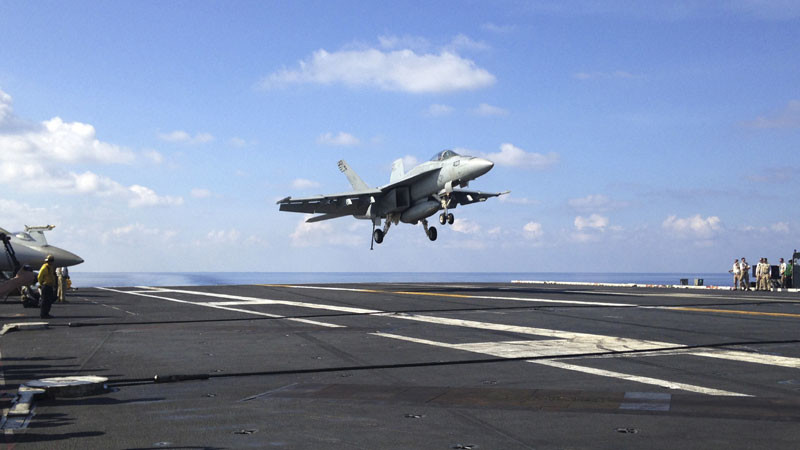
In this April 15, 2016, file photo, An FA-18 jet fighter lands on the USS John C. Stennis aircraft carrier in the South China Sea. U.S. Defense Secretary Ash Carter announced during a visit to Manila that for the first time U.S. ships had started conducting joint patrols in the South China Sea with the Philippines _ a somewhat rare move not done with many other partners in the region. (AP Photo/Lolita C. Baldor, File)
As a symbol of military force projection, nothing comes close to the aircraft carrier—especially the top-of-the-line American variety. When US Defense Secretary Ashton Carter landed aboard the USS John C. Stennis on Friday as it was conducting military exercises in the South China Sea, it was not simply to give his Philippine counterpart, Defense Secretary Voltaire Gazmin, a ringside seat at the war games. The unusual and high-profile visit, Carter’s second to a US Navy aircraft carrier in the same waters in less than six months, was also to telegraph to his counterparts in the Chinese security establishment the American game plan.
In pursuit of its stated goal of ensuring freedom of navigation in the South China Sea—parts of which Vietnam calls its East Sea, other parts of which the Philippines has renamed the West Philippine Sea—the American government signaled that it was ready to put military muscle behind its diplomatic position.
Greater US military engagement in the region was prompted by Beijing’s much more aggressive approach to the maritime disputes in the South China Sea in recent months, Carter said. “That’s a question of Chinese behavior.”
He added: “What’s new is not an American carrier in this region. What’s new is the context of tension exists, which we want to reduce.” This is rather like putting a gun on the table as people around that table raise their voices in argument. It could work and prevent the intense argument from spiraling out of control—or it could fail and raise both the stakes and the risks.
The two-hour visit to the carrier, which allowed Carter and Gazmin to watch F/A 18 Hornets take off from the flight deck and execute maneuvers, came on the heels of the announcement made Thursday that the United States and the Philippines would conduct more frequent joint patrols in the South China Sea.
That announcement naturally ruffled Beijing’s feathers. “The joint patrols between the United States and the Philippines in the South China Sea are militarizing the region and are nonbeneficial to regional peace and stability,” read an official statement issued immediately on a military website. “The Chinese military will pay close attention to the situation, and resolutely defend China’s territorial sovereignty and maritime interests.”
Carter’s visit to the Stennis, with as his special guests the defense secretary and the armed services chief of the Philippines, the one country that has challenged China at an arbitral tribunal, has only added to the “context of tension.”
From the point of view of both the Philippine and the American governments, the carrier visit and the joint patrols are only the necessary next steps in the carefully calibrated response to China’s increasingly aggressive conduct. After all, how should Washington and Manila (and other capitals in the region) protest Beijing’s deceptive reclamation work in the disputed area? China has created artificial islands with lighthouses and facilities that can be readily reengineered for military use. A display of resolve in the face of such a provocation is necessary.
And yet, whether it is the Americans saying so (the commander in chief of the US Pacific Command telling the US Senate last February: “In my opinion China is clearly militarizing the South China Sea. You’d have to believe in a flat earth to believe otherwise”) or the Chinese doing it (a senior foreign ministry official saying last year: “This has gone beyond the scope of freedom of navigation. It is a political provocation”), the result is the same: The United States and China are increasingly committed to a militarization track.
It’s well past time for the key players in the region to help create the conditions that will allow the Chinese to save face on the South China Sea issue; American power projection only stokes the fire of nationalism that is forging the new future of the Chinese Communist Party. At the same time, the United States must find another way to reassure its allies in the region of its support, without highlighting its military capability. Only then can the context of tension find an easing.